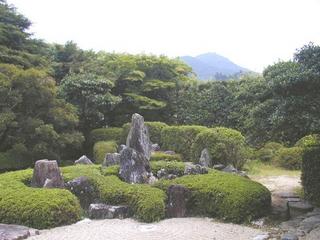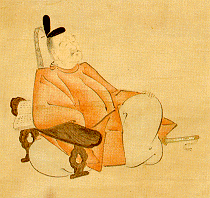:::::::::::::::::::::::::::::::::::::::::::::::::::::::::::::::::::::::::::::::::::::::::::::::::::::
Kobori Enshu 小堀遠州 (1579 - 1647)

He was a famous landscape gardener and I had a chance to visit one of his gardens at the Temple Raikyuu-Ji in Takahashi in July 2005.
岡山県、高梁市、頼久寺
慶長5年(1600年)小堀新介正次が、備中国に1万石余を領したが、慶長9年に逝去したので一子作介政一(遠州)が遺領を継いだ。その頃の松山城は備中兵乱で非常に荒廃していたため遠州は頼久寺を仮の館とし、またよく本寺を外護され、元和5年(1619年)までこの地にいた。本庭園はその頃の遠州の策定になるもので、蓬莱式枯山水庭園で愛宕山を借景し、白砂敷の中央に鶴島、後方に亀島の二つの低い築山状の島を置いて石を組み、書院左手の山畔に沿ってサツキの大刈込みで青海波を表現した庭園である。
このような築庭様式は、桃山から江戸初期に好まれたもので、現在まで旧体のまま保存されていることは、歴代城主の帰依の念篤きことと、歴代住職の愛山の念深きよるものであって、遠州作庭の傑作庭園と称されており、昭和49年国の名勝(庭園)指定された。尚、自筆の禁礼他遺愛品数点が保存されており、別に暦応2年12西念勧進による石灯篭がある。
http://www.optic.or.jp/takahashi-cci/kankou/kankou_c.html
Kobori designed many gardens, and many more claim to have him as originator (good for business nowadays...).
Kobori Enshu is maybe the best known garden master known inside and outside of Japan.

The temple garden in Takahashi is very quiet, with few visitors. Superbly fitted in the neighbouring mountains and slopes, to be appreciated through all the seasons.
The fine structure of the temple itself makes this a place of great restfullness and quietude.
The layout of sand, stones and shrubs exudes a fine quality of permanence and impermanence, change and non-change, action and non-action.
:::::::::::::::::::::::::::::::::::::::::::::::::::::::::::::::::::::::::::::::::::::::::::::::::::::
Enshu, Kobori
A master of tea, architecture, garden design, calligraphy and poetry, he was a multi-talented leader of early Edo culture.
Enshu was initially in the service of Hideyoshi's brother Hidenaga, but after that lord's death he aligned himself with Hideyoshi himself. Then, on Hideyoshi's death, he entered the service of Tokugawa Ieyasu.
In 1604, Enshu's father died suddenly leaving him in possession of the state of Omi, valued at 12,000 koku. He successfully completed works on the Sento Palace (the emperor's residence) and at Sunpu Castle, and was rewarded with the marshalcy of Omi. He also designed and constructed the keep of Nagoya Castle, Matsuyama Castle, and the study in the central enceinte of Fushimi Castle. Finally he built the central enceintes of the shogunal castle at Nijo-jo (in Kyoto) and of Osaka Castle.
His greatest claim to fame is as a tea master. He studied under Sen Rikyu's student Furuta Oribe, evolving a style of tea known as 'refined austerity', which aspired to fuse the classical court taste with that of the newer military elite. His role was pivotal in creation of the early modern tea ceremony, with its emphasis on self-cultivation and Confucianism.
Enshu designed many tea houses including the Hoden-seki in the subtemple of Koho-an at the Daitoku-ji, and the Mitsuan-seki at the Ryuko-in of the same temple. He was tea advisor to the shogunal family for fully 36 years.
Enshu's talents were many, and ran to garden design, architecture, calligraphy and poetry.
http://www.cartage.org.lb/en/themes/Biographies/MainBiographies/E/Enshu/enshu.htm
:::::::::::::::::::::::::::::::::::::::::::::::::::::::::::::::::::::::::::::::::::::::::::::::::::::

Kobori and the Enshu School of Tea
The founder, Lord Kobori Enshu Masakazu, was the feudal lord of Tohtoumi(now Shizuoka Prefecture) in the early Edo Era. He,along with Murata Juko, Takeno Jyoo, Senno-Rikyu, and Furuta Oribe,is renowed as one of the greatest tea masters to inherit the tradition of Japanese Sado(Tea Ceremony).
Enshu was a pivotal figure in the ruling circles, serving as the official tea instructor for the second and third Shoguns of Tokugawa, Hidetada and Iemitsu. He served as the magistrate of Fushimi in Kyoto and also as the construction commissioner in charge of building the famous castles such as Sunpu, Fushimi, Osaka, and Kyoto Nijo Castles. Such representative gardens in Kyoto as Daitokuji Kohoan, Katsura Rikyu, Nanzenji and Konchiin were built under his supervision and planning.
Enshu was also talented in calligraphy and waka, 31-syllable Japanese poetry. He originated a new style of tea ceremony, which is now called the Enshu Sado School. The spirit of Enshu Sado lies in " Kirei Sabi ", or gracefulness and simplicity. Kirei Sabi has its origin in ancient Japanese sense of beauty which is closely related to waka of the Heian period.
He also rendered great services in instructing potterymaking such as Takatori ware, Tanba ware, Shigaraki ware. Furthermore, he purchased specially designed tea utensils from China, Korea, Vietnam and the Netherlands.
COPYRIGHT (C) ENSHUSADO-SOKE
http://www.enshuryu.com/e-enshu.htm
.. .. ..
古田織部について茶をなし、江戸三代将軍徳川家光の師範となる。遠州流の始祖。造園、建築に深く貢献する。
http://www.teahyakka.com/glossary.html
:::::::::::::::::::::::::::::::::::::::::::::::::::::::::::::::::::::::::::::::::::::::::::::::::::::

Look at my photos from the temple garden, Raikyuu-Ji, Nr. A15 - A33.
.... Photo Album
Some Windows of Temples in Takahashi
Temple Window Shapes お寺の窓の形
:::::::::::::::::::::::::::::::::::::::::::::::::::::::::::::::::::::::::::::::::::::::::::::::::::::
Other gardens by Kobori Enshu in Japan:
Sento Gosho Palace
With the thing which Sento Gosho Palace commanded Kobori Enshu in the purpose that Tokugawa shogunate government pressed for abdication of the Emperor Gomizuno (1596-1680, rank 1611-29) and built, it was completed in 1630.
Now only a garden and a tea-ceremony room are left.
Sento Gosho Palace and the Omiya Imperial Palace built at the same time by expecting it are the Empress Dowager Imperial Palaces of the empress / east fortune Empress Dowager of the Emperor Gomizuno (1607-1678).
Minami Pond of Sento Gosho Palace was connected with Kita Pond that was a garden of the Omiya Imperial Palace in a canal in 1747.
In current Sento Gosho Palace, landscape gardening of Kobori Enshu does not convey an original figure faithfully.
Look at this page with many photos:
http://www.tvnet.co.jp/ai-guide/sendogosyo.html
.. .. .. .. ..
Temple Nanzen-Ji
As interesting as the Daihojo may be, it is the Shohojo that is of interest to most people for its screens (fusuma) decorated in Chinese landscapes as well as noted paintings of tigers and the kuresansui (dry garden) outside. Believed to be created by Kobori Enshu (1594-1634) it is this garden, known as the Tiger and Cubs Zen Garden, that attracts people to Nanzen-ji.
Like most Zen gardens it is not only important what is present in the garden, but what is not in the garden as well. Within the garden are three small rocks (the tigers) accompanied by three smaller rocks (the cubs) all surrounded by pure white sand (a stream). While some feel the shrubs within the garden distract the viewer from their meditative thoughts (Ryoan-ji is another dry garden with no "distractions) others view the space between the rocks and shrubs as the most important part of the garden.
Here they find the inner world and perhaps the "emptiness" of enlightenment.
"A Flower Does Not Talk"
Abbot Shibayama
http://www.yamasa.org/japan/english/destinations/kyoto/nanzenji.html
.. .. .. .. ..
Kyoto's Old Imperial Palace
Nijo Castle was built in the early seventeenth century as a temporary Kyoto residence for the Tokugawa Shogun. Its most famous garden is the one adjoining the Ninomaru Palace. Attributed to Kobori Enshu, it consists of a pond with three islands connected to the shore by bridges, the islands evoking one of the Daoist Isles of the Blest, the crane, and the turtle. Its large number of rocks has led some critics to view the garden as typical of the somewhat excessive designs of the Edo Period.
Choose a view point from the map or click Tour the Garden for more views of this garden.
http://academic.bowdoin.edu/zen/intro_template.shtml?nijo
.. .. ..
The garden at Houshi-beloved by Enshu Kobori
Enshu Kobori, a teacher of the tea ceremony to Iemitsu Tokugawa (third shogun of Tokugawa), is said to have stayed at Houshi when he visited Awazu. Whether this is true or not has never been ascertained, but it's very plausible given that Houshi's garden was created by Kobori who, in addition to being a great tea ceremony teacher, was also the originator of Enshu-style gardens. Recently, the garden artist Toemon Sano created a new garden at Houshi, which we are sure will enhance your perception of beauty when you stroll through our grounds.
http://www.ho-shi.co.jp/jiten/Houshi_E/yard.htm
.. .. ..
Imperial Villa Katsura
Daitokuji Hojo (the Chief Abbot's residence at Daitokuji Zen temple in Kyoto)
Kohoo-An (subtemple at Daitoku-Ji)
Katsura Rikyuu (桂離宮 (かつらりきゅう)

 is famous for its various stones in the garden. They come in all colors from all over Japan. Some are left naturally, some are cut and arranged to special patterns.
is famous for its various stones in the garden. They come in all colors from all over Japan. Some are left naturally, some are cut and arranged to special patterns.The various pavillions are arranged in a way that you can enjoy moon viewing during the whole night, sometimes seeing the moon doubled in the water of the pond.
The metal decorations to open the paper sliding doors are all beautifully decorated with seasonal patterns or some related to old poetry.
quote
Buildings and gardens
The Old Shoin, Middle Shoin and New Palace are each in the shoin style, with irimoya kokerabuki (柿葺) roofs. The Old Shoin shows elements of the sukiya style in places like the veranda. A space called the moon-viewing platform protrudes even farther from the veranda, and shows that the main theme of Katsura Detached Palace was moon-viewing.
The walls of the Middle Shoin and New Palace have ink-paintings by the school of Kanō Tan'yū (狩野 探幽). The shelving in the upper room of the New Palace is considered especially noteworthy.
The strolling garden takes water from the Katsura River for the central pond, around which are the Shōkintei (松琴亭), Shōkatei (賞花亭), Shōiken (笑意軒), and Gepparō (月波楼); tea houses, hill, sand, bridge, and lanterns. There is also a Buddhist hall, Onrindō (園林堂).
© More in the WIKIPEDIA !
Another speciality is the "live" wall made out of bamboo.
Katsuragaki かつらがき【桂垣】Katsura-Hedge
"takehoogaki" 竹穂垣, hoogaki 穂垣

made from the leaves of living bamboo. The bamboo is grown at a slope behind the woven bamboo fence and bent to hang over a woven bamboo support.
It is renewed every five years, inbetween the gardener has to select the bamboo that can stand and bend just in time to be ready for the hedge. The bend bamboo splits at the bend, but continues to be alive, this is a special kind of bamboo, hachiku 淡竹 Phyllostachys nigra (Lodd.) Munro var. henonis (Bean) Stapf.
::::::::::::::::::::::::::::::::::::::::::::::::::::::::::::::::::::::::::::::::::::::::::::::::::::
enlightenment stones
in the temple garden -
summer heat
Look at them here in Takanashi 2005
... ... ...
Read more about Japanese Gardens by Mark Schumacher.
Zen Garden Master Shunmyo Masuno 禅庭氏 増野さん
:::::::::::::::::::::::::::::::::::::::::::::::::::::::::::::::::::::::::::::::::::::::::::::::::::::
Contribution by Emile Molhuysen,
April 2008
*****************************
Back to the Daruma Museum Index
Back to the Daruma Forum








1 comment:
Gabi san
貴女の研究熱心には頭が下がります。
sakuo。
Post a Comment